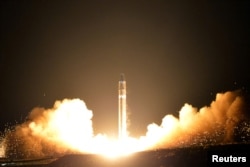North Korea’s recent Olympic peace offensive has reduced talk that the U.S. is preparing to give Pyongyang a “bloody nose” the next time it is provoked. But the controversial U.S. strategy to respond to continued North Korean missile or nuclear tests with a limited military strike reportedly remains an option under consideration.
In the last year tensions between North Korea and the United States have escalated over Pyongyang’s efforts to develop a nuclear-tipped missile capable of hitting the United States.
But North Korea’s agreement in January to send a large delegation of athletes, supporters and artists to the PyeongChang Olympics in South Korea has restarted an inter-Korean dialogue and reduced the possibility that Pyongyang will conduct another weapons test, at least until after the end of the games. The U.S. also agreed to postpone joint military exercises with South Korea until after the Olympics to accommodate the North’s peaceful participation.
U.S. Vice President Mike Pence, who will lead the U.S. Olympic delegation in South Korea, is not expected to engage with the North Korean delegation. Instead, a White House official said Tuesday, Pence will try to counter Pyongyang’s propaganda campaign seeking to present itself as a cooperative and non-threatening state.
There has been speculation that South Korean President Moon Jae–in will push for the continued suspension of the joint drills if North Korea agrees to enter denuclearization talks. But barring some diplomatic breakthrough, it is likely that Pyongyang will resume ballistic missiles and nuclear testing later this year.
“Bloody Nose” options
According to the Wall Street Journal the administration of President Donald Trump has been debating the idea of responding to the next provocation with a limited attack on a North Korean missile or nuclear facility. Such a surgical strike, supporters say, would damage Pyongyang’s weapons capabilities and intensify pressure on North Korean leader Kim Jong Un to agree to denuclearization talks.
Targeting a missile test site or intercepting a missile in flight is one option often discussed by military strike proponents, but critics point out that North Korea fires its ballistic missiles from mobile launchers that are hard to target in advance. Michael O'Hanlon, a foreign policy analyst at the Brookings Institution, says the odds of shooting down a North Korean missile mid-flight are probably 25 percent to 50 percent at best.
“So we could miss. We could wind up embarrassing ourselves. We could wind up having our interceptor land in a place it wasn’t supposed to, which is not clear we'll be successful,” said O’Hanlon at a recent Brookings event in Washington.
Taking out a North Korean nuclear research facility is another option often debated, but O’Hanlon said it will not halt weapons development as Pyongyang has numerous nuclear sites. Instead it could induce a massive nuclear meltdown that could put at risk the lives of millions in the region.
“You're going to spew radioactivity over a large swath of North Korea. I don't think that's a viable option for the United States on strategies or moral grounds,” he said.
There is also a high risk that North Korea would retaliate against a limited U.S. strike by attacking South Korea or Japan. A U.S. initiated conflict with North Korea could also prompt Chiina to come to the defense of its ally.
“I think [a U.S. strike] would be very reckless and I think it would actually alienate the allies and challengers in the region. It would marginalize the U.S. So from a U.S. foreign policy perspective, I think that is a mistaken view and has a number of risks involved,” said security analyst Daniel Pinkston, who is a lecturer in international relations with Troy University in Seoul.
Imposing a U.S. naval blockade of North Korea to enforce international sanctions has also been advocated as a possible third option, but such a move would be considered an international act of war, and possibly provoke a military confrontation with North Korean, Chinese or Russian ships that could also quickly escalate into war.
Imposing a U.S. naval blockade of North Korea to enforce international sanctions has also been advocated as a possible third option, but such a move would be considered an international act of war, and possibly provoke a military confrontation with North Korean, Chinese or Russian ships that could also quickly escalate into war.
Youmi Kim in Seoul contributed to this report.












